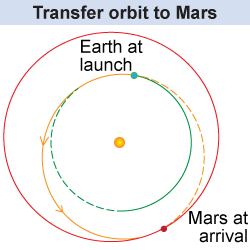|
| Essential questions | | How does velocity relate to a planet’s orbital radius?
How do you send a satellite from Earth to another planet’s orbit? | |
|
The planets in the Solar System orbit the Sun in ellipses—elongated circles—although many of the planets have nearly circular orbits. As a planet is placed further from the Sun, it experiences a smaller acceleration due to the Sun’s gravity; the planet’s velocity will therefore change with distance from the Sun to maintain a stable orbit. In this investigation you will determine the velocities of different planetary bodies in the Solar System and correlate these with their distances from the Sun. 
|
Part 1: Orbital velocities of the planets

- Using your computer, click on the interactive simulation in the electronic resources to conduct the investigation. Select Earth.
- Vary the orbital velocity v to find the best match for Earth’s true orbit. Record Earth’s minimum and maximum velocities and average distance from the Sun (semi-major axis).
- Repeat for the other seven planets.
- Write a hypothesis about which planets move faster or slower, outer planets or inner planets.
- From your results in the simulation, does Jupiter move faster or slower than the Earth? Does this evidence support or contradict your hypothesis?
- Using the simulation results, how does orbital velocity vary with distance from the Sun? Do these data support your hypothesis?
- Graph average orbital velocity v against distance from the Sun r. Is it a straight line?
- Devise a new graph of v against a different quantity derived from r that will be a straight line. Measure its slope (including its units).
- Using digital resources such as the Internet, research the average orbital speed for the eight planets. Compare the values with those you obtained from the simulation.

 |
Shapes of different orbits
As we learned on the previous page, the velocity of a planetary body determines the shape of its orbit. In the course of this investigation, you may generate all of the different shapes of orbits: circular, elliptical, and hyperbolic (including its special case of parabolic). Do large or small velocities produce hyperbolic orbits? 
|
On your computer, use this electronic resource (button on left) to launch the interactive simulation to conduct the investigation. In this simulation, you will create orbits for the planets, dwarf planets, and other Trans-Neptunian objects (TNOs). When you select a particular planet, its true orbit will be plotted in the simulation. You will adjust the initial orbital velocity—in particular, you are varying the velocity at its closest approach, known as the perihelion velocity vperi—in order to get the best match to its true orbit.
 |
Astronomical units
The interactive simulation displays the orbital radius for the planetary body in astronomical units (AU). One AU is the average radius of the Earth’s orbit, or approximately 1.5×1011 m. Venus orbits at a radius of 0.72 AU, whereas Jupiter orbits at a radius of 5.2 AU. What is the range in radii for Sedna’s orbit? 
|
Part 2: Transfer orbits
 To send a satellite from one planet to another, it is necessary to change the satellite’s velocity by using a trajectory called a transfer orbit.
To send a satellite from one planet to another, it is necessary to change the satellite’s velocity by using a trajectory called a transfer orbit. - Select Earth. Determine the initial velocity necessary to propel a satellite initially from Earth’s orbit to just reach Mars’s orbit.
- Compare the average velocity for Earth’s orbit (from Part 1) with the velocity necessary to reach Mars’s orbit. How much does the velocity have to change to reach a Martian orbit?
- What provides this change in velocity of the satellite?
- How much “elapsed time” does it take for this satellite to reach Mars? Compare this length of time to typical missions of the Space Shuttle and International Space Station. (Use digital resources to find out the typical mission lengths.)

 |
Part 3: Dwarf planets and trans-Neptunian objects
- Find the orbital velocities for the remaining seven objects.
- Which ones do you think are called trans-Neptunian objects? What do they have in common?
- What kind of object is Ceres, based on its location?
- Which object has the most unusual orbit? What is its orbital period in years?

|

